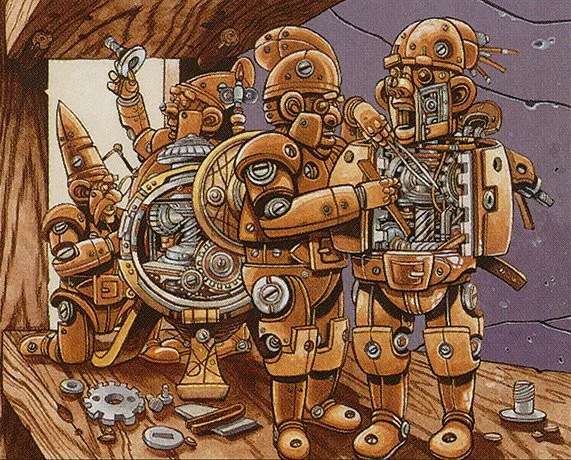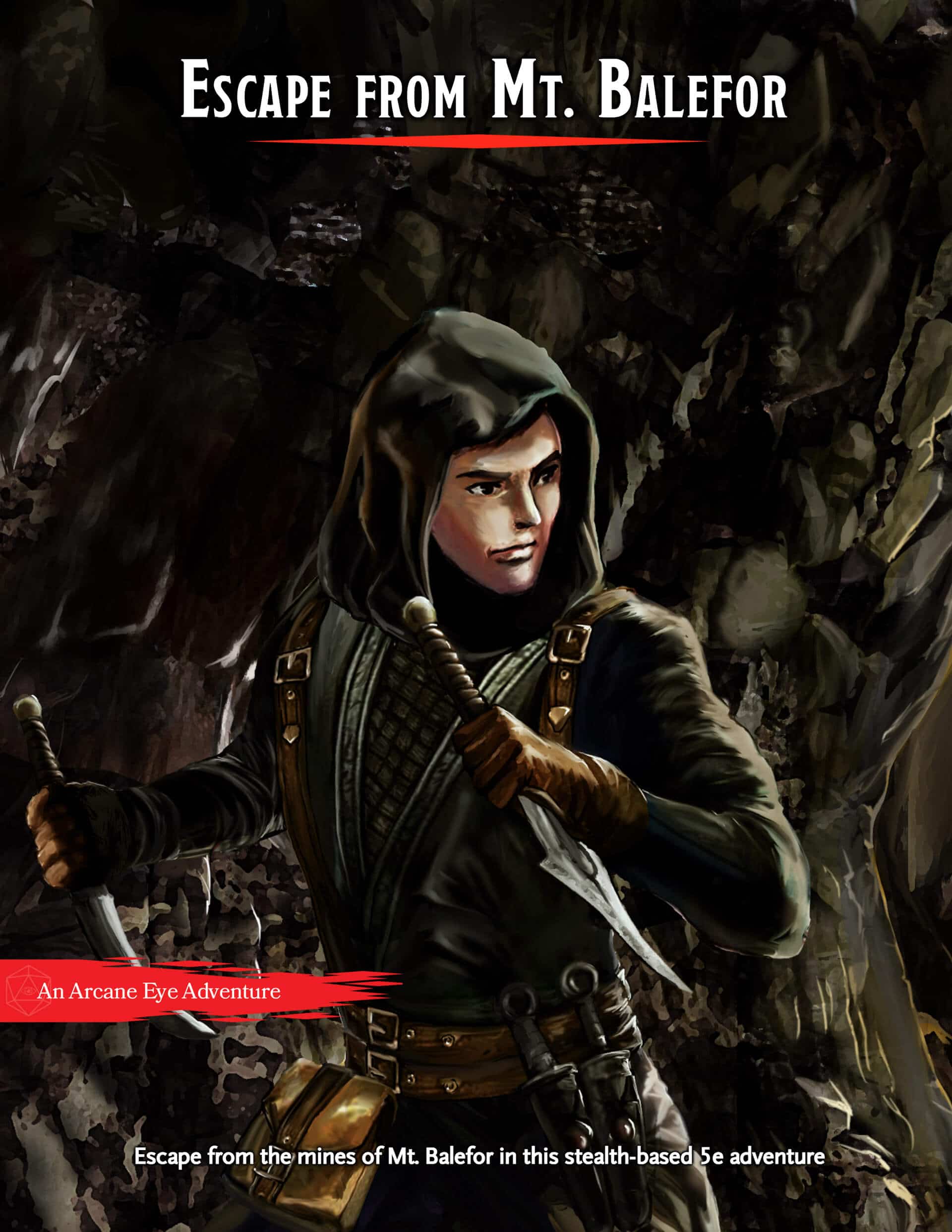Auto Gnome Guide 5e
Published on November 22, 2022
If the tale of Pinocchio has inspired you, you’ll love the chance to “be a real boy” with a sentient robotic auto gnome.

Jeff Laubenstein - Wizards of the Coast - Copper Gnomes
Arcane Eye may earn a small commission from affiliate links in this article.
Learn more.What is this guide?
This guide is meant to give you an idea of whether or not the auto gnome will be right for your 5e character build.
The color code below has been implemented to help you identify, at a glance, how good that option will be for your auto gnome. This color coding isn’t a hard and fast rule; there are plenty of sub-optimized options out there that will be viable to your party and will be fun to play.
- Black is a trait shared by many races and or will not impact the effectiveness of your character build
- Red isn’t going to contribute to the effectiveness of your character build at all
- Orange Situationally good, but a below-average option otherwise
- Green is a good option
- Blue is a great option, you should strongly consider this option for your character
- Sky Blue is an amazing option. If you do not take this option your character would not be optimized
Tasha's Cauldron of Everything Update
Tasha's Cauldron of Everything has added the "Customizing Your Origin" option that may affect the ability score increases, languages, and proficiencies in this guide. To read more about this, visit our D&D Race Guide.
What are Auto Gnomes in 5e?
Source: Spelljammer: Adventures in Space
Auto gnomes are sentient robotic creatures that were originally created by gnomes to function as mechanical servants. If an auto gnome is separated from its creator, it begins to develop more autonomy and can decide to strike out on its own adventures. Unlike other construct-like character races, like warforged, auto gnomes are inorganic and are therefore not Humanoids.
Auto Gnome 5e Traits
Ability Score Increase: Being able to choose between +2 ASI, +1 ASI, or +1, +1, +1 ASI means that you can pick exactly what your build will need.
Creature Type: Constructs cannot be targeted by spells that normally target Humanoids, like hold person, nor spells like normally target Fey, like protection from good and evil. This can innately allow auto gnomes to avoid some spell effects, even if magical resistance isn’t included as a racial ability.
Size: The Small size drastically limits builds that use heavy weapons.
Speed: 30 feet is the standard walking speed for most races. Previously, Small races usually had a reduced walking speed so it’s a nice plus to see the auto gnomes speed at 30 feet.
Armored Casing: This is a solid trait for classes that don’t normally wear armor, or who can only wear up to medium armor. 13 + DEX is better than light armor and is on par with mage armor. If you stack into DEX, you can easily get to 18 AC without having disadvantage on Stealth checks, which is a great defensive start for most lighter classes.
Built for Success: Being able to add a d4 to attack rolls, ability checks, and saving throws prof. modifier times per long rest is like having a pseudo bless active at all times, which is outstanding. The key here is you can use the d4 after seeing the result of your check, but before it resolves, allowing you to use this ability when it matters the most.
Healing Machine: The ability to expend a hit dice to heal when a cantrip is cast on your is an interesting resource trade off, but still extremely effective self-healing. Mending’s casting time of 1 minute prevents this from being an ability you can use in combat, however, which brings down the rating of this ability. The other big caveat to this ability is you either need to stock mending yourself or have a party member that knows the cantrip, which isn’t a crazy ask but can limit the effectiveness of this trait further.
Mechanical Nature: There are a lot of defensive abilities packed into this feature. Resistance to poison, immunity to disease, advantage against being paralyzed and poisoned, and you don’t need to eat, drink, or breathe. This wide variety of defensive capabilities are bound to come in handy and is one of the main benefits of not being a mortal creature.
Sentry’s Rest: While you have to remain inert for 6 hours, you remain conscious so you can still keep watch for your party, which is a nice little bonus.
Specialized Design: Unfortunately, tools are under-used in fifth edition. This will, however, allow you to pick up a proficiency in Thieves” Tools, which come up the most while adventuring. Your second pick can be whatever flavor you prefer.
Which 5e Classes Work With Auto Gnomes?
Auto gnomes can work for a wide variety of builds. Built for Success is best on characters that will be making lots of attack rolls, but their Armored Casing and Small size don’t necessarily work for heavy armor, heavy weapon, tank builds. In order to make the most out of all of their abilities, you’ll need a character that:
- Attacks often but doesn’t use heavy weapons
- Doesn’t have access to heavy armor and stacks into DEX
- Will be making skill checks, preferably with tools
- Wants a bit of extra healing and survivability
Artificer: Beyond the thematic feeling of being created by a tinkering gnome, then tinkering yourself, artificers don't really jive with the autognome's abilities. The auto gnome's natural armor is overshadowed by the artificer's infused medium armor and they don't have much cause to stack into DEX more than getting their +2 for AC. Artificers also already get plenty of tool proficiencies and have access to some healing spells.
Barbarian: The auto gnome's natural armor is rendered useless by the barbarian's Unarmored Defense and, unfortunately, their Small size restricts auto gnomes from wielding heavy weapons. The healing, extra survivability, and d4 to attack rolls are all tempting, but there are better options for barbarians out there.
Bard: Being skill monkeys, bards will love the extra tool proficiencies and d4 that Built for Success offers. They also don't normally get access to medium armor (unless you're going with a Valor or Swords build), which makes the auto gnome's natural armor a good AC boost. They also learn the mending cantrip, which can allow you to self-heal outside of combat.
Cleric: Seeing as clerics already get medium armor, they won't usually stack into DEX beyond the +2 they need for AC. They also already have plenty of ways to heal and access to bless, which can make some of the auto gnome's biggest assets irrelevant.
Druid: A robotic druid is an interesting combination that I'm not sure works in-universe, but if your DM green flags it, is a solid combination. The AC boost from the auto gnome's natural armor is welcome, as are the extra d4s that should conceivably work while wild shaped. But, the question is, would you turn into a robotic animal when wild shaping? These are the questions I have...
Fighter: While auto gnomes may be out for heavy armor, heavy weapon builds, they can make quite an effective ranged or DEX-based fighter. If you want your fighter to be a little more rouge-like, you can stack into DEX, get 18 AC without disadvantage on Stealth checks, add d4 to attack rolls and ability checks, get a proficiency with Thieves' Tools, and round it off with extra healing capabilities and some defensive boosts.
Monk: Monk's already get Unarmored Defensive, which makes the auto gnome's armor redundant. Beyond that, monk's will enjoy the ability to add d4 to their flurry of attacks, as well as the extra survivability the auto gnome's Construct creature type offers.
Paladin: Paladins rarely stack into DEX, which makes the auto gnome's natural armor a less tempting option than simply throwing on some heavy armor. Beyond this, the healing, extra survivability, and d4 to attack rolls are all tempting, but there are better options for paladins out there.
Ranger: While auto gnomes may be out for heavy weapon builds, they can make quite an effective ranged or DEX-based rangers. If you want your ranger to be a little more rouge-like, you can stack into DEX, get 18 AC without disadvantage on Stealth checks, add d4 to attack rolls and ability checks, get a proficiency with Thieves' Tools, and round it off with extra healing capabilities and some defensive boosts.
Rogue: Boosted AC, a d4 to add to attacks, skill checks, and saving throws, extra healing capabilities, some damage and condition resistances, and tool proficiencies are all appealing to rogues
Sorcerer: The AC boost is on par with mage armor, which could allow you to spend your limited sorcerer spells on other options. But, Built for Success doesn't apply to casters as much, nor does the tool proficiencies and survivability options. One of the biggest boons is you can self heal with mending, but seeing as it's not combat-ready healing and you only get to roll a d6, it doesn't make that much of a difference.
Warlock: The AC boost is on par with mage armor, which could allow you to spend your warlock invocations on other options as opposed to Armor of Shadows. But, the tool proficiencies and survivability options don't apply as much to your warlock, who will mainly be on the fringes of combat. The biggest boons warlocks get from auto gnomes are they can self heal with mending, but seeing as it's not combat-ready healing, it doesn't make that much of a difference, and Built for Success can apply to eldritch blast.
Wizard: The AC boost is on par with mage armor, but you have plenty of spells to spend on picking this option up. Built for Success also doesn't apply to casters as much, nor does the tool proficiencies and survivability options. One of the biggest boons is you can self heal with mending, but seeing as it's not combat-ready healing and you only get to roll a d6, it doesn't make that much of a difference.
Sources Used in This Guide
- BR: Basic Rules
- GotG: Bigby Presents: Glory of the Giants
- SotDQ: Dragonlance: Shadow of the Dragon Queen
- ERLW: Eberron: Rising from the Last War
- EEPC: Elemental Evil Player’s Companion
- EGtW: Explorer’s Guide to Wildemount
- FToD: Fizban's Treasury of Dragon
- GGtR: Guildmasters' Guide to Ravnica
- MotM: Monsters of the Multiverse
- MToF: Mordenkainen’s Tome of Foes
- MOoT: Mythic Odyessys of Theros
- PAitM: Planescape: Adventures in the Multiverse
- PHB: Player's Handbook
- SAiS: Spelljammer: Adventures in Space
- SCoC: Strixhaven: A Curriculum of Chaos
- SCAG: Sword Coast Adventurer’s Guide
- TCoE: Tasha’s Cauldron of Everything
- TTP: The Tortle Package
- WBtW: The Wild Beyond The Witchlight
- VRGtR: Van Richten's Guide to Ravenloft
- VGtM: Volo's Guide to Monsters
- XGtE: Xanathar’s Guide to Everything
Fill out the form below to receive Escape From Mt. Balefor for free!
Or follow us on Instagram, Twitter, and YouTube.


Not sure how it will work but I’m creating a Spelljammer Autognome druid (will be circle of stars at lev2) with Astral Drifter background (had a run in with Celestian, god of stars and wanderers), and it seems like a crazy but solid combo. No wild shape (or plant/animal focus but so it makes sense for an automation) but Starry Form will come in at lev2. Plus, lots of features from race, class, subclass, and background. And, not needing to breath could be helpful in Spelljammer. Wish me luck!